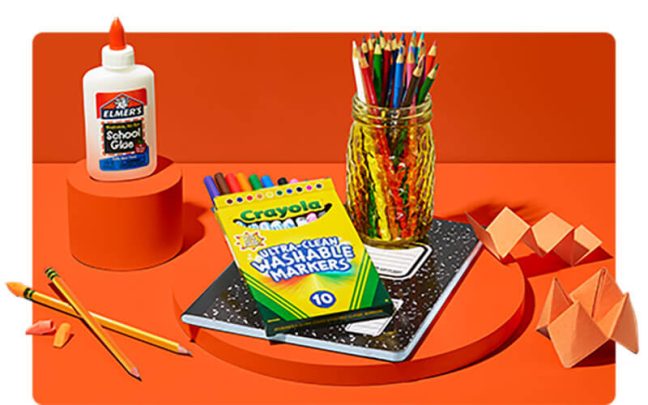It may be the dog days of summer, but many families have already made a dent in their back-to-school shopping. With about two months of spending under their belts, some interesting trends are beginning to emerge.
Chief among them is that increasing economic pressure is pushing consumers to adjust spending patterns, from how much they spend to where they spend it. Simply put, consumers are sacrificing loyalty to stay within budget.
According to a recent Deloitte survey, shoppers are forsaking specific retailers and brands in favor of finding the most affordable options for their children’s school supply needs, wherever that may be.
While industry reports disagree on how this shift will impact overall spending, at least one study anticipated that this fall, when the bulk of back-to-school spending is completed, flat to declining sales trends will emerge.
Where consumers are spending
Early shopping data shows online retailers and mass merchants were among the most popular sources for back-to-school shopping. Both online and brick-and-mortar retailers took an aggressive stance by pushing sales in May and June, winning consumers’ early spend.
What’s more, consumers are clearly demonstrating that they are willing to go to multiple retailers to complete their back-to-school lists in the pursuit of saving money.
However, given its protracted shopping season from June through late September, industry experts point out that back-to-school time is best viewed as a long game. That said, they expect August will be the busiest month for school shopping, which means retailers still have an opportunity to review their game plans for growing sales in the category.
And while there may have been an early uptick in online shopping, Sensormatic Solutions “2024 U.S. Back-to-School Consumer Sentiment Survey” found most parents, some 74 percent, will be visiting physical stores to make their purchases.
Sensormatic’s annual survey also found products tied to sustainability are gaining traction among school shoppers. Some 83 percent of respondents said sustainability will play a role in their purchasing decisions. Shoppers are prioritizing sustainable practices, such as using reusable shopping bags (45 percent), choosing products with sustainable packaging (41 percent) and opting for items made with eco-friendly materials like recycled paper and biodegradable pens (38 percent).
“With the rise in in-store traffic this time of year, it is critical that retailers look at their store operations and staffing to ensure they are meeting and exceeding consumer expectations by creating an environment that truly delivers,” said Grant Gustafson, head of retail consulting and analytics at Sensormatic.
Many parents say they are waiting for the best deals while others shop later because they don’t know what is needed yet.
“Getting it right means knowing your customers and being flexible enough to adapt to their needs. Drilling down into historical performance and shopper behavior insights can help retailers make sure their back-to-school plans hit the mark,” Gustafson said.
 Grocers can grab share
Grocers can grab share
Experts say there are several ways in which supermarkets can capture a share of the back-to-school business, many of which involve a back-to-basics approach.
Steve Markenson, VP of research and insights at FMI, points out that promotions, loyalty programs, cost comparison signage and cross merchandising are among the most effective measures to increase awareness and sales of non-food items in grocery stores.
In its “Power of Nonfoods at Retail 2023” report, Markenson highlighted that getting shoppers’ attention is a critical first step.
“Shoppers often have the perception that nonfood items cost more or don’t offer good value at grocery stores. Variety and selection, along with price/value, are seen as better at other retail locations,” he said.
Grocers who return to basics by merchandising and promoting nonfoods will be in a better position to overcome these perception barriers, he added.
Experts say anything retailers can do to help address shopper spending concerns is a win. That said, one of the top ways to do so is being a resource and assisting families with back-to-school prep.
For example, Kroger is using its blog, “The Fresh Lane,” to offer readers tips on freezer meal prep, school lunch ideas, dinner inspiration and quick breakfast options.
The grocer also announced plans to lock in low prices on hundreds of meal staples for breakfast, lunch and dinner. The price lock includes school supplies. Kroger has stocked hundreds of items for less than $3, covering essentials from pencil boxes and glue sticks to markers, notebooks and pens.
For its year-after-year effort, Kroger has been recognized by Crayola as a best-in-class retailer for its back-to-school aisle. Carlo Baldan, Kroger’s group VP of center store merchandising, called back-to-school “reset time for family routines,” including meal planning.
“At Kroger, we have shoppers’ back-to-school needs covered, from stocking backpacks to packing healthy lunches and affordable, easy dinner solutions for family,” he said.
Leveraging convenience and value, Meijer is letting consumers know it is serious about being a destination for school shopping for families and teachers. The retailer has made shopping for school easy by linking a QR code to more than 5,000 school supply lists. It also brought back a 15-percent-off coupon for teachers who buy school and home office items.
Looking to make the season cost friendly, Meijer introduced its own brand of back-to-school supplies that range from glue, glue sticks and crayons to markers and colored pencils. Karen Langeland, VP of merchandising for Meijer, said the retailer’s aim was to make it easy and stress free for today’s value-driven consumers to complete their shopping lists. She added that the program was created to help shoppers save money on quality items that help stretch budgets further.
[RELATED: Meijer Introducing School Supply List Technology Through App]
Value driving purchasing decisions
The rising cost of living is putting brand loyalty to the test, with consumers increasingly focused on finding the best deals. This is translating to a shift in back-to-school spending, with affordability prioritized over brand names.
By focusing on essential products, strategic promotions and leveraging in-store marketing alongside digital outreach, grocers can attract budget-conscious parents looking for convenience and value.
Here’s a few more ways grocers can grab back-to-school business:
- POS fundraisers: Partner with companies to create a round-up fundraiser with local schools selected as the recipient.
- Strategic product selection: Focus on essential school supplies like notebooks, binders, pencils, pens and highlighters. Partner with popular and affordable brands to offer variety without overwhelming shelves.
- Feature standout items: If space and consumer demographics warrant, consider offering unique options that play into trends like products made from sustainable materials.
- Targeted promotions: Create eye-catching displays featuring essentials alongside complementary grocery items like lunchbox snacks or healthy drinks. Highlight special bundle deals to incentivize larger purchases.
- In-store marketing: Utilize high-traffic areas near registers or entrances for eye-catching displays with back-to-school essentials. Directional signage can guide customers toward these displays.
- Leverage digital strategies: Promote back-to-school deals through email marketing, social media campaigns and loyalty program rewards. Highlight specific deals and create a sense of urgency to drive traffic.
- Pro tip: Remember, convenience is key. Parents juggling busy schedules appreciate one-stop shopping. By offering essential school supplies alongside groceries, food retailers can be seen as a convenient destination.

